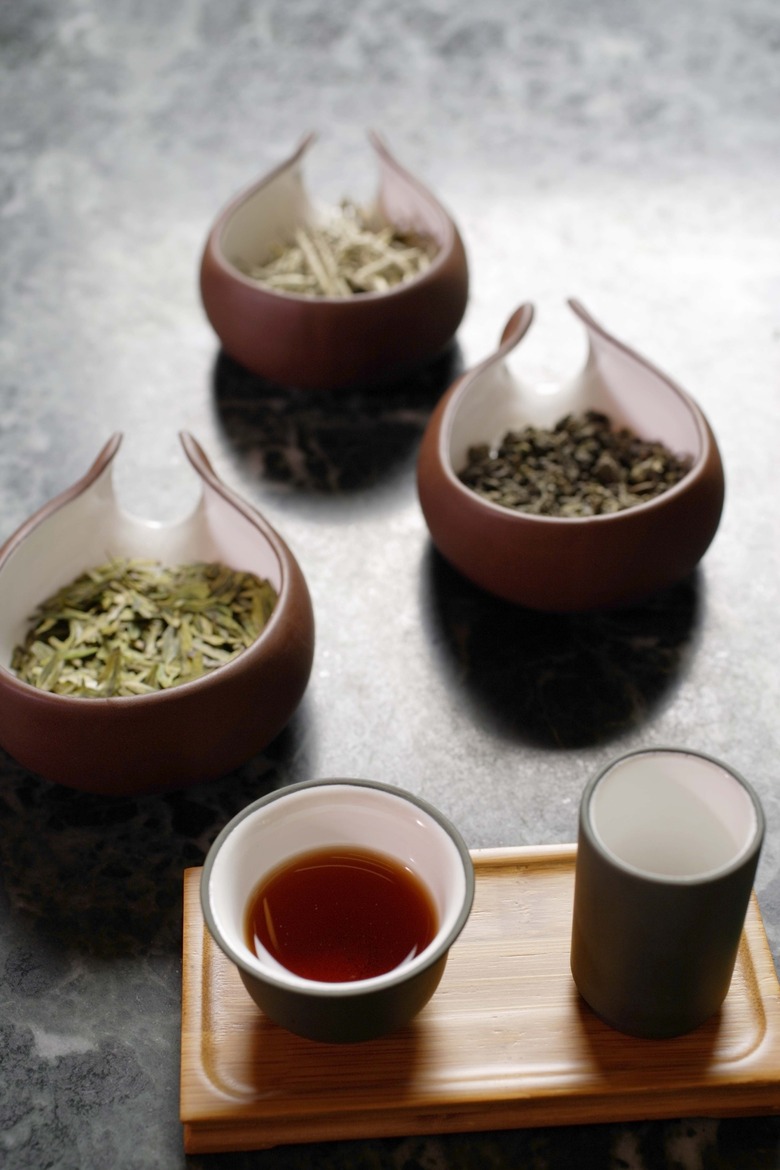Is There Any Good To Adding Tea Leaves To A Garden?
Used teabags and loose leaf tea are an organic and compostable materials that can be used to add beneficial minerals and nutrients to your garden or compost pile. As water comes in contact with tea, nutrients are leached from the leaves, infusing the water with extracts, flavonoids and essential oils, all of which contain nutrients. But not all plants respond well to tea as an amendment. It is important to understand how and when to add tea leaves so you do not harm your plants.
Tannic Acid
Step 1
Tannic acid is a naturally occurring acidic substance in tea. While this may not be a problem in certain soils, depending on the pH level, tannic acid can lower the pH, creating an acidic environment that is unfavorable for some plants. To determine if tea leaves are appropriate for your garden, regularly check your soil's pH level. If the pH is too high, tea leaves may be a good thing. Otherwise, only use tea leaves on plants that do well with a low pH.
- Used teabags and loose leaf tea are an organic and compostable materials that can be used to add beneficial minerals and nutrients to your garden or compost pile.
- As water comes in contact with tea, nutrients are leached from the leaves, infusing the water with extracts, flavonoids and essential oils, all of which contain nutrients.
Plants That Respond Well
Step 1
Plants that will do well with tea leaves and grow best with a low pH — acid-loving plants — include blueberries (Vaccinium myrtillus), sweet potatoes (Ipomoea batatas), beans (Phaseolus vulgaris), tomatoes (Solanum lycopersicum), rhubarb (Rheum rhabarbarum), broccoli (Brassica oleracea) and peppers (Capsicum). Blueberries are perennials that thrive in U.S. Department of Agriculture plant hardiness zones 5 through 7, although some varieties withstand temperatures in USDA zones 3 and 8. Rhubarb grows as a perennial in USDA zones 3 through 8. Perennial plants that prefer a low pH include azaleas (Rhododendron spp.), which grow in USDA plant hardiness zones 4 through 9, and roses (Rosa spp.), which grow in USDA zones 2 through 9, depending on the variety. Plants that do better with a pH above 6.5 should not have tea leaves applied directly to them.
- Plants that will do well with tea leaves and grow best with a low pH — acid-loving plants — include blueberries (Vaccinium myrtillus), sweet potatoes (Ipomoea batatas), beans (Phaseolus vulgaris), tomatoes (Solanum lycopersicum), rhubarb (Rheum rhabarbarum), broccoli (Brassica oleracea) and peppers (Capsicum).
- which grow in USDA plant hardiness zones 4 through 9, and roses (Rosa spp.
- ),
Adding Tea Leaves
Step 1
You can use tea leaves in two ways. The first is to use tea as mulch, sprinkling a layer leaves on the surface of the soil around the base of your plants. Another way is to work moist tea leaves into the garden soil as you prepare your soil for the season's plantings. It is OK to use both fresh and dried or old tea leaves. While paper teabags are biodegradable, they are unsightly, so it is best to remove the tea from the bag before adding it to your garden.
Benefits
Step 1
When rainwater comes in contact with tea leaves, the nutrients within the leaves slowly leach into the soil and are available for uptake by your garden plants. Tea leaves act as a slow-release fertilizing amendment, so you do not have to worry about plant injury due to rapid-nutrient release. As tea leaves break down and decompose, they add additional organic matter to the soil. Soils that are rich in organic matter are the healthiest, as they attract beneficial insects and organisms, like earthworms. They also have better drainage and aeration which is important for keeping pests and diseases at bay.
- You can use tea leaves in two ways.
- While paper teabags are biodegradable, they are unsightly, so it is best to remove the tea from the bag before adding it to your garden.
Tea Leaves and Compost
Step 1
If you prefer, you can add tea leaves to your garden indirectly, through your compost pile. Paper teabags and loose leaf teas are biodegradable organic materials that improve the nutrient and moisture content of your compost. Tea leaves can speed up the rate of decomposition, in addition to attracting beneficial bacteria that create a rich, acidic compost. Once the compost is mature, add it to your garden soil to improve it.
References
- Mother Earth Living: Plants Need Tea Too
- Reader's Digest: 22 Ways to Use Tea for Beauty, Home and Garden
- Colorado State University Extension: Acid-Loving Plants
- New Mexico State University Extension & Outreach: Coffee Ground and Tea Leaves are Good for New Mexico Gardens
- Cornell University Gardening: Rhubarb
- The Old Farmer's Almanac: Rhododendrons and Azaleas
- Rose Magazine: Rose Hardiness Zone Map
